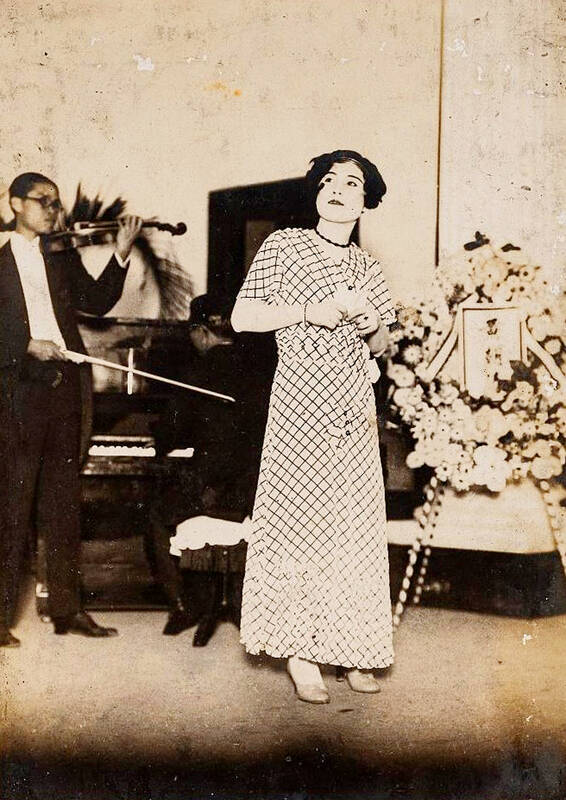Oct. 13 to Oct. 19
When ordered to resign from her teaching position in June 1928 due to her husband’s anti-colonial activities, Lin Shih-hao (林氏好) refused to back down. The next day, she still showed up at Tainan Second Preschool, where she was warned that she would be fired if she didn’t comply. Lin continued to ignore the orders and was eventually let go without severance — even losing her pay for that month.
Rather than despairing, she found a non-government job and even joined her husband Lu Ping-ting’s (盧丙丁) non-violent resistance and labor rights movements. When the government’s 1931 crackdown on political activism led to Lu’s eventual disappearance, Lin remained resilient, reinventing herself as a famous singer to support her mother — who also raised her as a single parent — and three children.

Photo courtesy of Online Database of Taiwanese Musicians
Unlike other pop divas of the era, Lin was classically trained (largely self-taught) and often performed solo concerts. She toured Taiwan twice and vowed to promote Taiwanese folk music worldwide.
“I wish to restore the dignity of Taiwanese folk music and correct the long-held misconception that it is crude and unsophisticated. I hope that, through proper treatment and widespread performance, these songs can become the true new folk music of Taiwan,” she told the Osaka Asahi Shimbun in 1935.
Several songs in her diverse repertoire were penned by Lu, including Poem of Parting (離別詩), which seemed to fortell their separation. Lu’s fate is unclear, but evidence suggests that he was held for a time at the Losheng Sanitarium and may have been deported to China, writes Huang Hsin-chang (黃信彰) in Labor Movement, Songs and Anti-Colonialism (工運 歌聲 反殖民).

Photo courtesy of National Museum of Taiwan Literature
MUSICAL AWAKENING
Lin was born on Oct. 15, 1907, in Tainan. Her father died when she was young, and her mother supported the family by selling pastries, while encouraging Lin to pursue her education.
She was introduced to music through the Taipingjing Presbyterian Church (太平境教會), but her greatest inspiration was world-famous opera singer Tamaki Miura. Lin saved up to attend Miura’s 1920 performance in Tainan, which left a lasting impression.
At 16, Lin completed her teacher’s training and began teaching music at Tainan Third Public School. That year, she met Lu, the brother of a colleague and also an educator. The two soon began dating and got married on Lunar Valentine’s Day.
In March 1924, Lin transferred to Tainan Second Preschool, where she would work until her dismissal. By then, Lu had left teaching to devote himself to activism, working closely with Chiang Wei-shui (蔣渭水) through the Taiwanese Cultural Association.
Charismatic and eloquent, Lu drew thousands to his speeches across the colony, also becoming a leading figure in the labor rights movement. In 1927 he co-founded the Taiwanese People’s Party — the first of its kind.
JOINING THE CAUSE
Activism in Taiwan was at its peak, but the arrival of new governor-general Takeji Kawamura in June 1928 marked the beginning of tightening colonial control.
That year, Lu helped establish the Tainan Incense Workers’ Association. Within months, the group had nearly 100 members and successfully negotiated with the incense factory owners for better conditions. In retaliation, several association officers were dismissed. Lin stepped in, helping the workers pool their resources and form their own company, which quickly gained popularity. Alarmed, the owners offered to rehire the workers, but they refused.
Lin also sought to establish a Tainan Women’s Association, although patriarchal attitudes and government interference repeatedly got in the way. In 1930, she co-founded Taiwan’s first all-female poetry society and supported the push to romanize the Hoklo language (commonly known as Taiwanese).
That same year, the Taiwan New Minpao newspaper organized simulated local elections – five years before officials permitted actual elections. Both Lin and Lu ran in Tainan; Lu finished second for Tainan Prefecture councilor, while Lin was elected city councilor.
The Taiwanese People’s Party was forced to disband in 1931, and Lu, along with other activists, was briefly detained. Lin made another attempt to set up the women’s association, but the authorities barred her from participating.
POP STARDOM
Lu maintained a low profile, his last reported action being a protest in front of the Tainan Police Department on behalf of 200 workers detained for supporting the industry strikes in Taipei. Lin pretty much lost contact with him after 1932.
That October, Lin auditioned for the pioneering Columbia Records and was signed as the label’s first Taiwanese artist. Her debut solo radio concert on Dec. 27, was met with widespread acclaim, with listeners writing in to express admiration. At the time, she primarily performed Japanese songs, but the Taiwanese pop scene was about to blow up (see “Taiwan in Time: Taiwan’s first ‘pop song’?”, March 9, 2025).
Lin’s classical voice stood out from the other singers, most of whom were former banquet hall entertainers or Taiwanese opera performers. In 1933, she recorded her first single, Cry of the Maroon Oriole (紅鶯之鳴), which became a hit alongside the record’s flip side, Dancing Age (跳舞時代) by Chun-chun (純純), Taiwan’s first pop star. This record sold between 10,000 and 20,000 copies, Huang writes.
Its release was heavily promoted: a 30-car motorcade paraded through Taipei’s busiest streets for over a week with a live band performing. On Nov. 29, Lin performed at the Tainan Assembly Hall. Although the concert was free, attendees had to obtain tickets from the record store, and thousands attended.
Between 1933 and 1936, Lin recorded 14 songs, moving in 1934 to Taiping Records, and held 19 live solo performances across Taiwan. Her first tour in February 1935 was highly touted, with a Taichung newspaper reporting: “If you wish to appreciate the highest form of art, hurry and attend the solo concert of the popular singer Lin Shih-hao. One would rather skip a meal than miss the chance to hear her exquisite voice.”
Her second tour raised funds for the deadly Hsinchu-Taichung Earthquake, which killed more than 3,300 people and injured 12,000.
TRAINING AND LATER YEARS
Up to this point, Lin never received formal vocal training, learning primarily by listening to records by Miura’s renowned student, Toshiko Sekiya, and mimicking her technique to near-perfection.
The two met on Feb. 10, 1935, when Lin was performing at the hotel Sekiya was staying at. Sekiya, who had reportedly turned down numerous students worldwide, offered to train Lin. After concluding her fundraising tour in June, Lin headed to Japan to study under Sekiya for a year, an event widely reported in the press.
Lin returned in 1936 and prepared to relaunch her career, but the outbreak of the Second Sino-Japanese War led to the suppression and demise of Taiwanese pop. She moved her family to Japan and remained active in the music scene.
After World War II, Lin joined the Chinese Nationalist Party’s (KMT) Three Principles Youth Group and performed all over China before heading home in 1946. In 1948, she moved north and continued singing while teaching music.
During the 1950s, her daughter Lin Hsiang-yun (林香芸) emerged as a talented dancer. Together, they formed a troupe and often performed internationally. In 1961, Lin retired from performing after undergoing surgery to remove a tumor from her tongue. She died in 1991.
Taiwan in Time, a column about Taiwan’s history that is published every Sunday, spotlights important or interesting events around the nation that either have anniversaries this week or are tied to current events.

In recent weeks the Trump Administration has been demanding that Taiwan transfer half of its chip manufacturing to the US. In an interview with NewsNation, US Secretary of Commerce Howard Lutnick said that the US would need 50 percent of domestic chip production to protect Taiwan. He stated, discussing Taiwan’s chip production: “My argument to them was, well, if you have 95 percent, how am I gonna get it to protect you? You’re going to put it on a plane? You’re going to put it on a boat?” The stench of the Trump Administration’s mafia-style notions of “protection” was strong

Late last month US authorities used allegations of forced labor at bicycle manufacturer Giant Group (巨大集團) to block imports from the firm. CNN reported: “Giant, the world’s largest bike manufacturer, on Thursday warned of delays to shipments to the United States after American customs officials announced a surprise ban on imports over unspecified forced labor accusations.” The order to stop shipments, from the US Customs and Border Protection (CBP), came as a surprise to Giant, company officials said. Giant spokesman Ken Li (李書耕) said that the CPB never visited the company’s factories to conduct on-site investigations, nor to interview or

Every now and then, it’s nice to just point somewhere on a map and head out with no plan. In Taiwan, where convenience reigns, food options are plentiful and people are generally friendly and helpful, this type of trip is that much easier to pull off. One day last November, a spur-of-the-moment day hike in the hills of Chiayi County turned into a surprisingly memorable experience that impressed on me once again how fortunate we all are to call this island home. The scenery I walked through that day — a mix of forest and farms reaching up into the clouds

“Eighteen years ago, people didn’t even know the name of this ingredient,” says 58-year-old Gil Sa-hyeon, holding up a cluster of dried brownish stems. “Now it’s everywhere.” His shop, Joseon Yakcho, sits in the heart of Seoul’s Yangnyeongsi Market, South Korea’s largest traditional medicinal herb market, its streets lined with shops displaying buckets of herbs such as licorice root and cinnamon bark that spill on to the pavements, filling the air with their distinct, earthy aroma. The ingredient Gil is referring to is hovenia dulcis, known in Korean as heotgae — the oriental raisin tree that’s become the cornerstone of South Korea’s